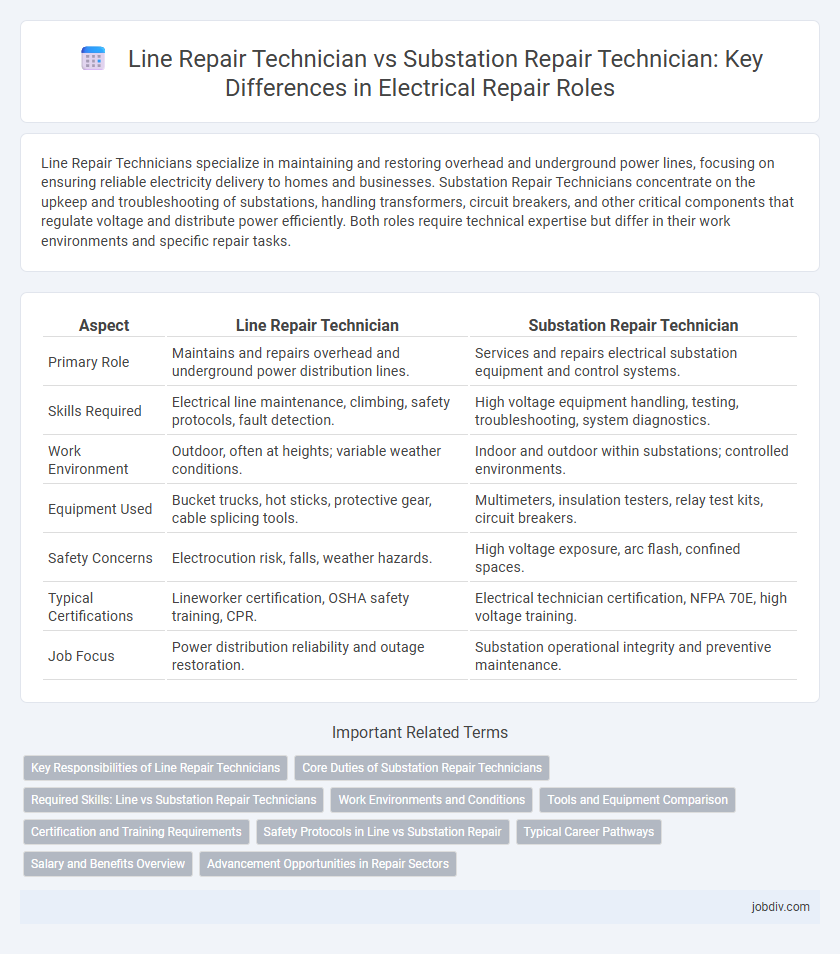Line Repair Technicians specialize in maintaining and restoring overhead and underground power lines, focusing on ensuring reliable electricity delivery to homes and businesses. Substation Repair Technicians concentrate on the upkeep and troubleshooting of substations, handling transformers, circuit breakers, and other critical components that regulate voltage and distribute power efficiently. Both roles require technical expertise but differ in their work environments and specific repair tasks.
Table of Comparison
| Aspect | Line Repair Technician | Substation Repair Technician |
|---|---|---|
| Primary Role | Maintains and repairs overhead and underground power distribution lines. | Services and repairs electrical substation equipment and control systems. |
| Skills Required | Electrical line maintenance, climbing, safety protocols, fault detection. | High voltage equipment handling, testing, troubleshooting, system diagnostics. |
| Work Environment | Outdoor, often at heights; variable weather conditions. | Indoor and outdoor within substations; controlled environments. |
| Equipment Used | Bucket trucks, hot sticks, protective gear, cable splicing tools. | Multimeters, insulation testers, relay test kits, circuit breakers. |
| Safety Concerns | Electrocution risk, falls, weather hazards. | High voltage exposure, arc flash, confined spaces. |
| Typical Certifications | Lineworker certification, OSHA safety training, CPR. | Electrical technician certification, NFPA 70E, high voltage training. |
| Job Focus | Power distribution reliability and outage restoration. | Substation operational integrity and preventive maintenance. |
Key Responsibilities of Line Repair Technicians
Line Repair Technicians specialize in maintaining and restoring overhead and underground power lines, ensuring electrical continuity and safety for residential and commercial customers. Their key responsibilities include inspecting utility poles, diagnosing faults, replacing damaged conductors, and facilitating emergency repairs during outages. These technicians must also adhere to strict safety protocols while working at heights and in hazardous conditions to prevent service disruptions and maintain grid reliability.
Core Duties of Substation Repair Technicians
Substation repair technicians specialize in maintaining and repairing electrical equipment within substations, such as transformers, circuit breakers, and protective relays to ensure reliable power distribution. Their core duties include performing diagnostic tests, troubleshooting faults, conducting routine inspections, and replacing damaged components to prevent outages. These tasks require expertise in high-voltage systems and adherence to stringent safety protocols specific to substation environments.
Required Skills: Line vs Substation Repair Technicians
Line Repair Technicians require expertise in climbing poles, working at heights, and handling live electrical lines with precision and safety tools. Substation Repair Technicians need specialized knowledge of high-voltage equipment, control systems, and the ability to diagnose and repair complex electrical components within substations. Both roles demand strong problem-solving skills and adherence to safety protocols, but substation technicians focus more on technical diagnostics while line technicians emphasize physical endurance and safety in outdoor environments.
Work Environments and Conditions
Line Repair Technicians primarily work outdoors in various weather conditions, often at heights on utility poles or transmission towers, requiring physical endurance and safety precautions for high-voltage environments. Substation Repair Technicians operate mainly within substations, dealing with complex electrical equipment in controlled but potentially hazardous environments, emphasizing precision and technical expertise. Both roles demand strict adherence to safety protocols, but Line Technicians face more exposure to environmental elements, while Substation Technicians encounter confined spaces and intricate system components.
Tools and Equipment Comparison
Line Repair Technicians primarily use insulated hand tools, hot sticks, cable cutters, and bucket trucks designed for overhead power line maintenance. Substation Repair Technicians rely on specialized test equipment such as insulation resistance testers, circuit breaker analyzers, and torque wrenches to handle high-voltage switchgear and control panels. Both roles require safety gear like gloves and helmets, but the technical tools differ to suit their specific repair environments.
Certification and Training Requirements
Line Repair Technicians typically require certifications such as OSHA safety training, CPR, and specialized lineman training programs, often including a Journeyman Lineman certification. Substation Repair Technicians need more advanced training in electrical systems, often requiring certifications like NETA (InterNational Electrical Testing Association) and specialized substation maintenance courses. Both roles demand extensive hands-on apprenticeship experience but differ significantly in technical focus and certification specificity.
Safety Protocols in Line vs Substation Repair
Line Repair Technicians follow strict safety protocols such as de-energizing power lines, using insulated tools, and implementing fall protection measures to prevent electrical hazards and falls from heights. Substation Repair Technicians adhere to rigorous lockout/tagout procedures, wear personal protective equipment (PPE) like arc flash suits, and perform thorough ground testing to mitigate risks from high-voltage equipment and potential arc flashes. Both roles emphasize adherence to OSHA standards and continuous safety training to ensure a secure working environment during repair activities.
Typical Career Pathways
Line Repair Technicians often start as apprentices, gaining hands-on experience with overhead and underground power lines before advancing to supervisory roles or specializing in high-voltage systems. Substation Repair Technicians typically begin with technical training in electrical systems, progressing through roles such as junior technician and senior technician, with opportunities to move into equipment design or maintenance management. Both career pathways emphasize certifications like OSHA safety and NERC compliance to ensure expertise and industry standards adherence.
Salary and Benefits Overview
Line Repair Technicians typically earn an average annual salary ranging from $50,000 to $70,000, with benefits including health insurance, retirement plans, and overtime pay. Substation Repair Technicians often command higher salaries between $60,000 and $85,000 due to specialized skills, complemented by similar benefits packages and potential bonuses. Both roles offer job security and opportunities for career advancement within the utility industry.
Advancement Opportunities in Repair Sectors
Line Repair Technicians have advancement opportunities through specialization in high-voltage line maintenance, pole-top rescue operations, and supervisory roles in distribution network management. Substation Repair Technicians can progress by developing expertise in relay protection systems, control circuit troubleshooting, and transitioning into senior roles like substation engineer or maintenance coordinator. Both sectors offer pathways to management positions and continuous training in advanced diagnostic technologies, enhancing career growth in the electrical repair industry.
Line Repair Technician vs Substation Repair Technician Infographic

 jobdiv.com
jobdiv.com